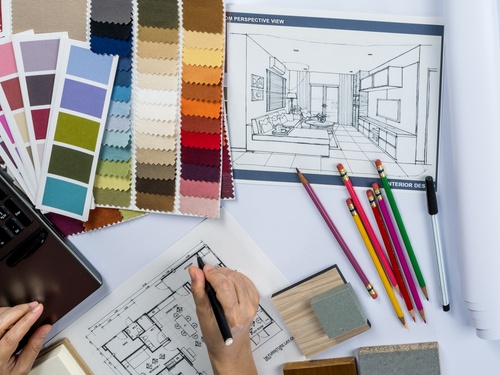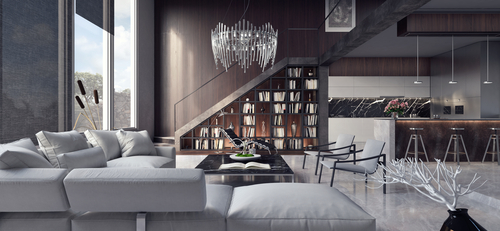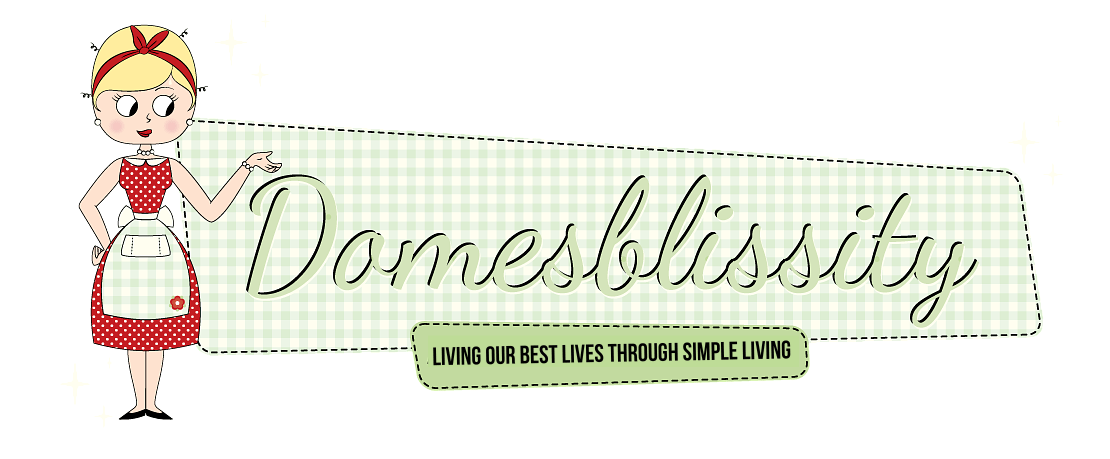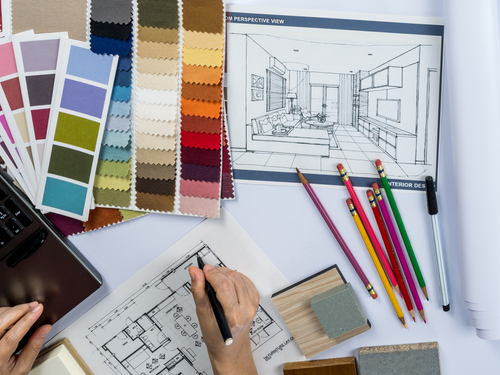Building your home is truly a milestone in your life. But, for you to turn it into that space that you’ve long dreamed of, you’ve got to be willing to go through each step of the planning process as meticulously as possible. When it comes to interior design + build, here are details to include when planning for your home.

Interior Design + Build
Contrary to popular belief, planning for your home doesn’t only require having the measurements of the floor space, the types of fixtures to be installed and the materials to be used. For your home to create a pleasant and livable environment, you should also pay attention to its interior design.
How your home looks and feels on the inside can significantly affect your mood, your family’s and the visitors you’ll accommodate in the future. You’ll want you home to feel as accommodating and comfortable as possible. After a long day out, this should feel like a retreat that you’re excited to go home to. Little ad-ons here and there can help elevate that overall relaxing feeling of your home.
A well-decorated home makes it very easy to relax while one which is chaotic and disorganized can lead to more stress. If you want to experience the former, be aware of the following details.
Purpose of the room
Designing the rooms in your home can get too overwhelming that you end up buying every furniture and art pieces you come across. Even when you’re excited about this process, give yourself time to think each detail through. Take time to window shop together with your interior designer.
To help you determine what you should and shouldn’t do with the interior design of your house, think about the purpose of each room and put this on top of your list. All other factors can follow suit later once the purpose has already been achieved and the budget still permits for these extras.
- All of the rooms in your home has different purposes. This means that how your living area looks like should be different from the bedroom and dining area. When it comes to interior design, the color scheme, furniture, layout and overall theme of the room should be based on what the room is mostly used for. This would also be dependent on the home designs that you’re looking for and trying to replicate.
- For example, all homes have living areas, but not all are used in the same way. Some use their living areas to host a weekly game night which is why board games, gaming consoles and storage furniture for gaming tapes and CDs are essential. For families who enjoy movies and sports, expect that their living areas will have widescreen TVs, soft cushions and tables for foods and drinks.
- Ask yourself how you will use each room in the house and focus the design around its function. Are you solely using your bedroom for sleeping or are you planning to work here, as well? A convertible and sturdy table can be handy. Do you love to cook different kinds of meals in your own kitchen? Make sure that you’re renovating a kitchen to be equipped with the necessary appliances and tools.
Research and budget when planning your home
Solely knowing the purpose of each room in the house isn’t enough for you to come up with a solid interior design. You should also have an idea of how you want your home to look like. How are you planning to change the space? Will you buy new furniture or use old ones? What theme do you want your home to have – modern or traditional?
- Take time to look for interior design inspirations from different sources. A handful of websites such as MOOD Design + Build, can give you an idea of the latest trends in interior designs and how you can copy these for your own home. Pictures from magazines and Pinterest boards can also help.
- Once you know what you want, it’ll be easier to know what to buy, as well. Based on the design inspirations you saw, start gathering paint chips, flooring samples and fabric swatches which you can use.
- During this process, you’ll be able to come up with a budget based on the details that truly matter to you. Are you looking forward to a bedroom which has the coziest linens, pillows, and carpets or are you planning to impress your guests with art pieces in your living area? Find ways to achieve the interior design that you want without spending too much. You don’t want to waste money buying unnecessary accent pieces and decors, while disregarding essential appliances and furniture.
Layout of the room

The layout of the rooms in your house is like a painter’s canvas – you’ll have to make the most of the available space to achieve your interior design goals. Check the sizes and scales of the rooms, the home’s interior and exterior architecture and the neighborhood around you. Don’t just take the measurements of the rooms but include the surroundings, too.
- Take a graph paper and start mapping out the layout of each room in the house. You can do this on your own if you know how or hire interior designers to do it for you. Use a tape and put this in different areas of the graph paper, as if the furniture or appliance. Doing this can help you organize the rooms better while making sure that you’ll only purchase items which can actually fit.
- Investing in expensive furniture or appliances and later find out that these only cramped up space in a room is the last thing you want to worry about. Preparing a layout can prevent this from happening, especially if you only have limited space in your home.
- All of the rooms also have physical limitations. This means that aside from the measurements, you also have to consider the electrical outlets, fireplaces, doors and windows. All of these things should be drawn in the layout, as well.
Free space when planning your home
Although it can be tempting to fill a room with the latest appliances and expensive furniture, don’t do it. Free space is also an important factor in interior design. When your room doesn’t have too much space, free space can trick you into thinking that it’s larger from its actual size. Free space can also reserve the room just in case you’re planning to add a few furniture over time.
- For you to become an interior designer (in your own rights), don’t aim to fill every space in your rooms. Appreciate free space because sometimes, less is more.
- Overcrowding can lead to stress – something you don’t want to experience when you enter a room. On the other side of the coin, free space can make you feel more calm and peaceful. It can even make your room feel and look cleaner.
- Aside from making your room aesthetically pleasing, free space can also reinforce the activities done in the room and improve the flow of traffic, too. More free space means more area to move around.
Features and Benefits of Interior Design + Build
When designing and building a home, you should take into consideration the features and benefits. Don’t just put in certain features in your home for the sake of doing so. Else, you’ll only be wasting money. Every corner of your room should have a purpose that should be beneficial to you and the rest of the family.
Working with one of the best home improvement contractors will help you attain your home new construction or renovation goals.
Here are the features and benefits you might want to consider when designing and building your dream home:
- Number of Bedrooms: The number of rooms you need will increase depending on how many children you have. Some parents want their children to share bedrooms, whereas others like separate bedrooms for better study habits. Also, you need to consider welcoming regular visitors so that you can designate a guest room. Also, an additional room can be used as a home office, playroom, or home gym.
- Number of Bathrooms: Do you need a single or two bathrooms? How about a bathtub or jacuzzi? Do other family members needs a handicapped accessible bathroom? The number of bathrooms depends on the size of your family, guests, and visitors who might be using the bathrooms.
- Kitchen Layout: The kitchen is the home’s center of entertainment and activity. That’s why the layout and size are important. When designing your kitchen, be clear with your contractor as to the space you need for your sink, storage, and counter space. Also, consider your cooking style and if you prefer entertaining a lot of guests or you have a large family to feed when designing your kitchen.
- Smart Home Features: Automation is not just a trend in interior design. Smart home refers to a home with tight security features and functions can be remotely controlled even if you’re not at home using automation via the internet. Consider installing home security features, automated window treatments and shutters, and other smart home features for security and peace of mind.
- Energy-efficiency: Design your room to be energy-efficient by constructing skylights and installing cool roofs. These skylights, for instance, may be costly at the outset since they’re made of glass. But, because it enables you to have the maximum natural light to come in during the day, you’re also saving up on electricity expenses in the long term.
Interior Design: Take The Opportunity when Planning Your Home
Planning for your home is like starting with a clean slate – you’ll have to start from the very beginning before you and your family can enjoy a fully-furnished home.
Just like any other thing in life, the best things always come in as a result of great hard work. So, if you want your home to be what you envisioned it to become, you’ve got to be willing to go through all the dirty work first. That means ample preparation.
Instead of looking at the situation as a difficulty, consider it as an opportunity for your home to have an interior design which suits your preference. Take heed also of all the wishes and opinions of every family member of your home. That way, you can truly make it a space to call your very own. Along with your patience and meticulousness, this article can help you build your dream house soon!




